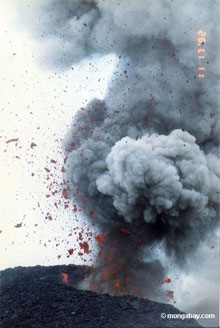Volcanic eruption cut warming in 20th century
Rhett A. Butler, mongabay.com
February 9, 2006
EDITOR’S NOTE: Ocean temperatures might have been warmer and sea levels would have risen higher in the 20th century had Krakatoa not erupted in 1883, said a team of scientists. According to the researchers, the release of ashes and aerosols into the upper atmosphere had a significant long-term impact on global climate.
A release from Lawrence Livermore National Laboratory, one of the institutions involved in the research, appears below.
Volcanoes helped slow ocean
warming trend, researchers find
Lawrence Livermore National Laboratory Release
Ocean temperatures might have risen even higher during the last century if it weren’t for volcanoes that spewed ashes and aerosols into the upper atmosphere, researchers have found. The eruptions also offset a large percentage of sea level rise caused by human activity.
Using 12 new state-of-the-art climate models, the researchers found that ocean warming and sea level rise in the 20th century were substantially reduced by the 1883 eruption of the Krakatoa volcano in Indonesia. Volcanic aerosols blocked sunlight and caused the ocean surface to cool.
“That cooling penetrated into deeper layers of the ocean, where it remained for decades after the event,” said Peter Gleckler, an atmospheric scientist at Lawrence Livermore National Laboratory (LLNL). “We found that volcanic effects on sea level can persist for many decades.”
Gleckler, along with LLNL colleagues Ben Santer, Karl Taylor and Krishna AchutaRao and collaborators from the National Center for Atmospheric Research, the University of Reading and the Hadley Centre, tested the effects of volcanic eruptions on recent climate models. They examined model simulations of the climate from 1880 to 2000, comparing them with available observations.
External “forcings,” such as changes in greenhouse gases, solar irradiance, sulphate and volcanic aerosols, were included in the models.
Oceans expand and contract depending on the ocean temperature. This causes sea level to increase when the water is warmer and to recede in cooler temperatures.
 Anak Krakatau (child of Krakatoa) eruption on November 17, 1992. Photo by Nancy Butler. More photos of the Krakatoa eruption. The 1883 eruption of Krakatoa—a volcano near the Indonesian island of Rakata—ejected more than six cubic miles (25 cubic kilometers) of rock, ash, and pumice and generated the loudest sound ever recorded by human beings. The tsunami that followed the eruption killed 36,417 people according to official records. The eruption destroyed two-thirds of the pre-existing island of Krakatoa and subsequent eruptions at the volcano since 1927 have built a new island, called Anak Krakatau. Anak Krakatau has since erupted on several occasions including the pictures eruption in 1992. |
The volume average temperature of oceans (down to 300 meters) worldwide has warmed by roughly .037 degrees Celsius in recent decades due to increasing atmospheric greenhouse gases. While seemingly small, this corresponds to a sea level rise of several centimeters and does not include the effect of other factors such as melting glaciers. That sea level jump, however, would have been even greater if it weren’t for volcanic eruptions over the last century, Gleckler said.
“The ocean warming suddenly drops,” he said. “Volcanoes have a big impact. The ocean warming and sea level would have risen much more if it weren’t for volcanoes.”
Volcanic aerosols scatter sunlight and cause the ocean surface temperature to cool, an anomaly that is gradually subducted into deeper layers, where it remains for decades.
The experiments studied by Gleckler’s team also included the more recent 1991 Mt. Pinatubo eruption in the Philippines, which was comparable to Krakatoa in terms of its size and intensity. While similar ocean surface cooling resulted from both eruptions, the heat-content recovery occurred much more quickly in the case of Pinatubo.
“The heat content effects of Pinatubo and other eruptions in the late 20th century are offset by the observed warming of the upper ocean, which is primarily due to human influences,” Gleckler said.
The research appears in the Feb. 9 issue of the journal Nature.
Founded in 1952, Lawrence Livermore National Laboratory has a mission to ensure national security and apply science and technology to the important issues of our time. Lawrence Livermore National Laboratory is managed by the University of California for the U.S. Department of Energy’s National Nuclear Security Administration.
Related articles
Poisonous volcanic gas probably caused worst mass extinction says new study
The mass extinction event at the end of the Permian — where more than two-thirds of reptile and amphibian families perished and 95% of oceans life forms became extinct — was probably caused by poisonous volcanic gas, according to research published in the journal Geology. The researchers believe that volcanic gases from the eruption, near present day Siberia, depleted earth’s protective ozone layer and acidified the land and sea.
Global warming may have triggered worst mass extinction
A dramatic rise in carbon dioxide 250 million years ago may have caused global temperatures to soar and result in Earth’s greatest mass extinction, according to a study published in the September issue of Geology. Global warming, which may have produced temperatures 10 to 30 degrees Celsius higher than today, would have had a significant impact both on oceans, where about 95% of lifeforms became extinct, and on land, where almost 75% of species died out.
This article includes a modified news release from Lawrence Livermore National Laboratory.